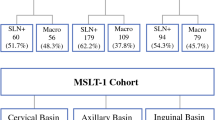Abstract
Background
The main aims of this study were to evaluate the occurrence of the various forms of locoregional recurrence in sentinel node–positive melanoma patients, to determine whether the different definitions that are being used to describe in-transit metastases influence this rate, and to identify factors associated with locoregional recurrence. A comparison was made with the rate of locoregional recurrence in patients who underwent lymph node dissection for palpable metastases.
Methods
Between December 1993 and December 2008, a total of 141 patients underwent completion lymph node dissection because of a tumor-positive sentinel node. In the same period, 178 patients underwent a regional lymph node dissection for palpable nodal metastases.
Results
In the sentinel node–positive patients, the local recurrence rate was 5%, the rate of satellite metastasis was 2%, and for in-transit metastasis, it was 15%. In patients with palpable nodal involvement, these values were 3%, 2%, and 14%, respectively. There was no statistically significant difference in locoregional recurrence-free rates between these two groups of node-positive patients (P = .172). Breslow thickness was the only predictive factor for locoregional recurrence (P = .015).
Conclusions
The rate of locoregional metastases in patients with a tumor-positive sentinel node and patients with palpable nodal involvement is similar. The present study refutes the suggestion that a positive sentinel node indicates a predisposition for developing in-transit metastases.

Similar content being viewed by others
References
Morton DL, Thompson JF, Cochran AJ, et al. Sentinel-node biopsy or nodal observation in melanoma. N Engl J Med. 2006;355:1307–17.
Estourgie SH, Nieweg OE, Kroon BBR. High incidence of in-transit metastases after sentinel node biopsy in patients with melanoma. Br J Surg. 2004;91:1370–1.
Estourgie SH, Nieweg OE, Valdés Olmos RA, Hoefnagel CA, Kroon BBR. Review and evaluation of sentinel node procedures in 250 melanoma patients with a median follow-up of 6 years. Ann Surg Oncol. 2003;10:681–8.
Statius Muller MG, van Leeuwen PA, van Diest PJ, et al. Pattern and incidence of first site recurrences following sentinel node procedure in melanoma patients. World J Surg. 2002;26:1405–11.
Van Poll D, Thompson JF, Colman MH, et al. A sentinel node biopsy does not increase the incidence of in-transit metastasis in patients with primary cutaneous melanoma. Ann Surg Oncol. 2005;12:597–608.
Pawlik TM, Ross MI, Johnson MM, et al. Predictors and natural history of in-transit melanoma after sentinel lymphadenectomy. Ann Surg Oncol. 2005;12:587–96.
Doting MH, Hoekstra HJ, Plukker JT, et al. Is sentinel node biopsy beneficial in melanoma patients? A report on 200 patients with cutaneous melanoma. Eur J Surg Oncol. 2002;28:673–8.
Thomas JM, Clark MA. Selective lymphadenectomy in sentinel node–positive patients may increase the risk of local/in-transit recurrence in malignant melanoma. Eur J Surg Oncol. 2004;30:686–91.
Van der Ploeg IM, Valdés Olmos RA, Nieweg OE, et al. The additional value of SPECT/CT in lymphatic mapping in breast cancer and melanoma. J Nucl Med. 2007;48:1756–60.
Nieweg OE, Tanis PJ, Kroon BBR. The definition of a sentinel node. Ann Surg Oncol. 2001;8:538–41.
Klaase JM, Kroon BBR, van Geel AN, et al. Prognostic factors for tumor response and limb recurrence-free interval in patients with advanced melanoma of the limbs treated with regional isolated perfusion with melphalan. Surgery. 1994;115:39–45.
Pawlik TM, Ross MI, Thompson JF, Eggermont AM, Gershenwald JE. The risk of in-transit melanoma metastasis depends on tumor biology and not the surgical approach to regional lymph nodes. J Clin Oncol. 2005;23:4588–90.
Kretschmer L, Beckmann I, Thoms KM, et al. Factors predicting the risk of in-transit recurrence after sentinel lymphonodectomy in patients with cutaneous malignant melanoma. Ann Surg Oncol. 2006;13:1105–12.
Van der Ploeg IM, Kroon BB, Antonini N, Valdes Olmos RA, Nieweg OE. Is completion lymph node dissection needed in case of minimal melanoma metastasis in the sentinel node? Ann Surg. 2009;249:1003–7.
Starz H, Siedlecki K, Balda BR. Sentinel lymphonodectomy and s-classification: a successful strategy for better prediction and improvement of outcome of melanoma. Ann Surg Oncol. 2004;11:162S–8S.
Nieweg OE, Estourgie SH. What is a sentinel node and what is a false-negative sentinel node? Ann Surg Oncol. 2004;11:169S–73S.
Calabro A, Singletary SE, Balch CM. Patterns of relapse in 1001 consecutive patients with melanoma nodal metastases. Arch Surg. 1989;124:1051–5.
Borgognoni L, Urso C, Vaggelli L, et al. Sentinel node biopsy procedures with an analysis of recurrence patterns and prognosis in melanoma patients: technical advantages using computer-assisted gamma probe with adjustable collimation. Melanoma Res. 2004;14:311–9.
Vuylsteke RJ, van Leeuwen PA, Statius Muller MG, et al. Clinical outcome of stage I/II melanoma patients after selective sentinel lymph node dissection: long-term follow-up results. J Clin Oncol. 2003;21:1057–65.
Gershenwald JE, Schacherer C, Emerson M, et al. Patterns of failure and survival analysis in sentinel lymph node positive melanoma patients. Proc Am Soc Clin Oncol. 2001. Abstract.
Clary BM, Mann B, Brady MS, Lewis JJ, Coit DG. Early recurrence after lymphatic mapping and sentinel node biopsy in patients with primary extremity melanoma: a comparison with elective lymph node dissection. Ann Surg Oncol. 2001;8:328–37.
Singletary SE, Tucker SL, Boddie AW Jr. Multivariate analysis of prognostic factors in regional cutaneous metastases of extremity melanoma. Cancer. 1988;61:1437–40.
Buzaid AC, Ross MI, Balch CM, et al. Critical analysis of the current American Joint Committee on Cancer staging system for cutaneous melanoma and proposal of a new staging system. J Clin Oncol. 1997;15:1039–51.
Balch CM, Buzaid AC, Soong SJ, et al. Final version of the American Joint Committee on Cancer staging system for cutaneous melanoma. J Clin Oncol. 2001;19:3635–48.
Kretschmer L, Beckmann I, Thoms KM, et al. High incidence of in-transit metastases after sentinel node biopsy in patients with melanoma (Br J Surg. 2004;91:1370–1371). Br J Surg. 2005;92:253–4.
Author information
Authors and Affiliations
Corresponding author
Rights and permissions
About this article
Cite this article
Veenstra, H.J., van der Ploeg, I.M.C., Wouters, M.W.J.M. et al. Reevaluation of the Locoregional Recurrence Rate in Melanoma Patients With a Positive Sentinel Node Compared to Patients With Palpable Nodal Involvement. Ann Surg Oncol 17, 521–526 (2010). https://doi.org/10.1245/s10434-009-0776-y
Received:
Published:
Issue Date:
DOI: https://doi.org/10.1245/s10434-009-0776-y




